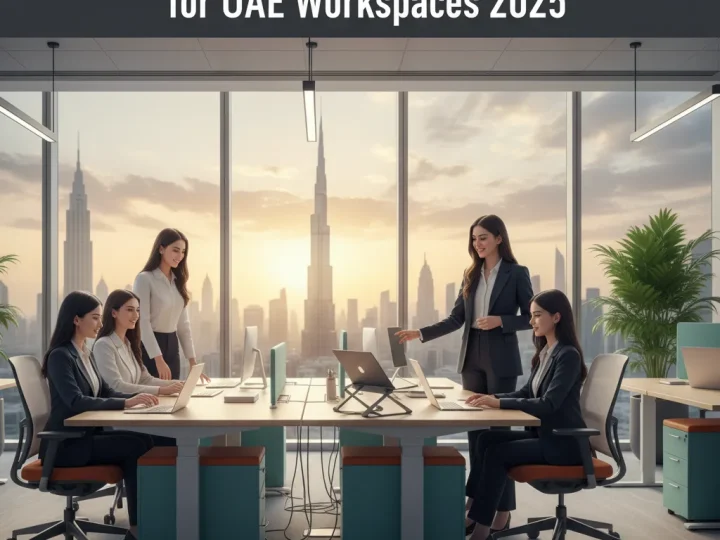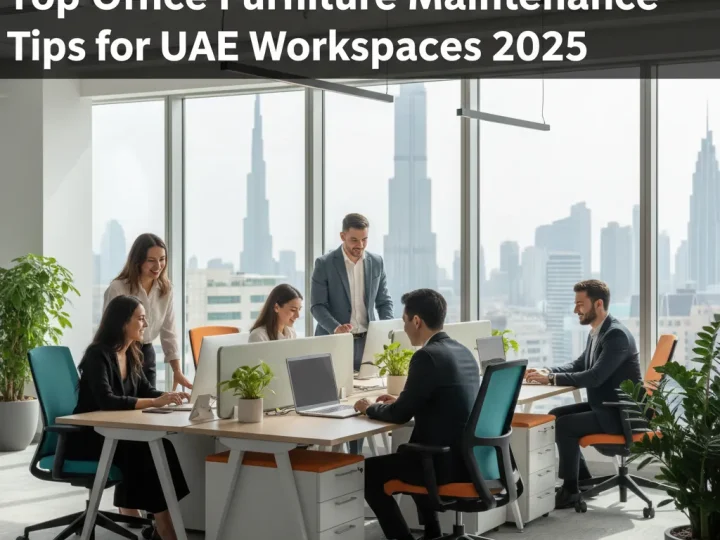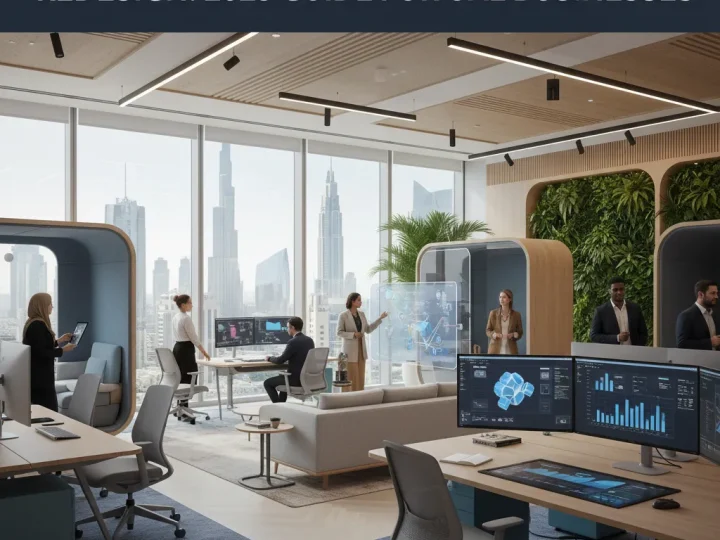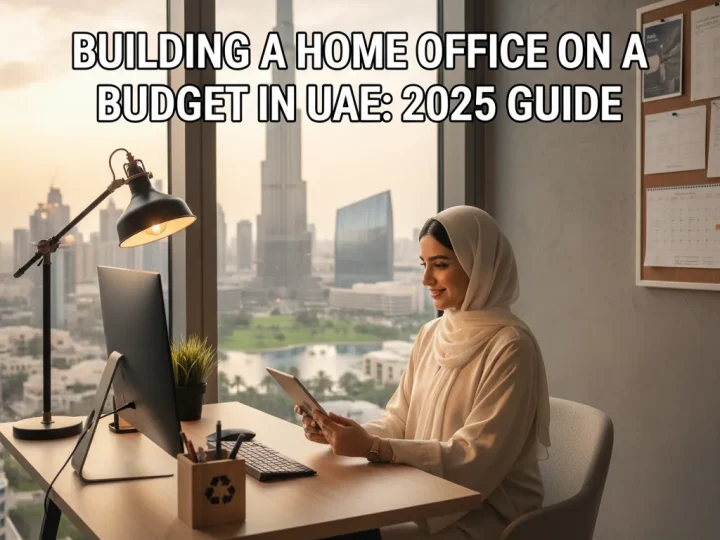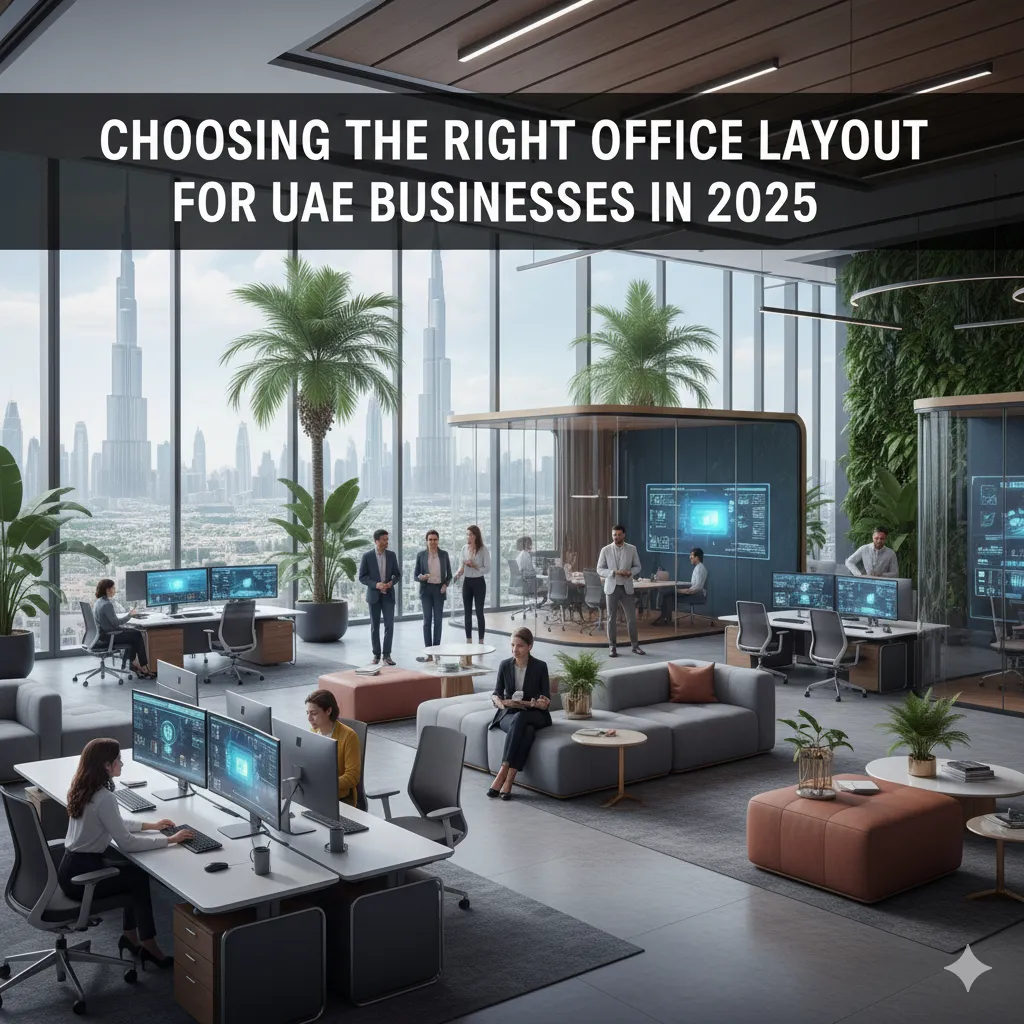
Office design in the UAE is getting a major upgrade for 2025. Research shows that modern layouts can directly impact productivity, with one study linking office design to changes in workplace interaction and efficiency across 32 global companies. Think closed-off cubicles are a thing of the past? Surprisingly, open spaces can sometimes make things noisier and harder to focus. The real key is balancing privacy, culture, and flexibility—something most businesses miss entirely.
Table of Contents
- Understanding Office Layout Types And Their Benefits
- Key Factors To Consider For UAE Workspaces
- Customizing Your Office Layout For Dubai Startups
- Expert Tips For Office Furniture And Space Planning
Quick Summary
| Takeaway | Explanation |
|---|---|
| Consider Office Layout Types | Businesses should evaluate traditional, modern, open-plan, activity-based working, and hybrid layouts to align workspace design with operational needs and team dynamics. |
| Account for Cultural and Environmental Factors | UAE office designs must respect local cultural expectations while addressing environmental challenges, such as integrating eco-friendly materials and managing solar heat effectively. |
| Emphasize Flexibility and Technology | Modular and adaptable workspace designs are crucial for startups, enabling quick reconfiguration and integration of technology to support collaboration and innovation. |
| Prioritize Ergonomics and Well-being | Implement ergonomic furniture solutions to enhance employee comfort and productivity, and create diverse work zones to cater to various work styles and tasks. |
| View Design as a Strategic Investment | Companies should consider office design as a long-term investment in employee productivity and satisfaction rather than merely a cost, maximizing workspace potential through thoughtful planning. |
Understanding Office Layout Types and Their Benefits
Choosing the right office layout is a critical decision that directly impacts workplace productivity, employee satisfaction, and organizational performance. Modern businesses must carefully evaluate different office design strategies to create environments that support their unique operational needs and team dynamics.

Traditional vs. Modern Office Layout Approaches
Traditional office layouts typically featured closed individual offices or cubicle arrangements that prioritized individual work and privacy. These designs created clear hierarchical structures where managers occupied private spaces and employees worked in structured, segmented environments. Explore contemporary office design strategies that challenge these conventional approaches.
In contrast, modern office layouts emphasize flexibility, collaboration, and adaptable workspace configurations. According to a systematic literature review of 32 empirical studies, office design significantly influences workplace interaction and productivity. These contemporary designs aim to break down physical and psychological barriers between team members, creating more dynamic and interconnected work environments.
Key Office Layout Types
Businesses can choose from several primary office layout types, each with distinct advantages:
- Open Plan Offices: Characterized by shared, unrestricted spaces that encourage communication and collaboration. While these layouts promote transparency, research analyzing 42,764 office worker responses indicates potential challenges with noise levels and reduced privacy.
- Activity Based Working (ABW): Provides multiple workspace zones for different tasks, allowing employees to select environments matching their current work requirements. This approach supports diverse work styles and enhances overall workplace flexibility.
- Hybrid Layouts: Combines elements of traditional and modern designs, offering private workspaces alongside collaborative areas. These layouts recognize that different tasks and individual preferences require varied workspace configurations.
The most effective office layouts balance individual needs with collective organizational objectives. Businesses must consider factors like team size, work nature, communication requirements, and company culture when designing their workspace. While open-plan and flexible designs facilitate interaction, they do not automatically guarantee increased innovation or interdisciplinary collaboration.
Careful planning, employee consultation, and adaptable design principles are essential when choosing an office layout. The goal is creating an environment that supports productivity, employee well-being, and organizational growth.
For businesses seeking detailed guidance on optimizing their workspace, our comprehensive office furniture guide provides additional insights into creating functional and inspiring work environments.
To help compare the main office layout types discussed, the following table summarizes their core features, benefits, and potential challenges:
| Layout Type | Key Features | Benefits | Potential Challenges |
|---|---|---|---|
| Open Plan | Shared, unrestricted spaces; minimal barriers | Encourages collaboration and transparency | High noise, reduced privacy |
| Activity Based Working | Multiple zones for different tasks; choice of workspace | Supports diverse work styles; increases flexibility | Requires careful planning |
| Hybrid | Blend of private and collaborative areas | Balances privacy with team interaction | May increase complexity |
| Traditional | Closed offices/cubicles; hierarchical arrangement | High privacy; clear structure | Less adaptable, limits teamwork |
Key Factors to Consider for UAE Workspaces
Selecting the optimal office layout requires a strategic approach that goes beyond aesthetic considerations. For UAE businesses in 2025, workspace design must balance functionality, cultural nuances, technological integration, and employee well-being.
Cultural and Environmental Considerations
The UAE workplace environment presents unique challenges and opportunities for office design. Cultural expectations of privacy, professional interactions, and workspace hierarchy play significant roles in layout decisions. Explore innovative design strategies for Dubai workspaces that respect local business practices while embracing modern workplace trends.
Environmental factors are particularly crucial in the UAE. High temperatures and intense sunlight demand innovative design solutions. According to research from sustainable design experts, integrating eco-friendly materials and strategic natural light positioning can significantly enhance workplace comfort and sustainability. Considerations include:
- Solar Heat Management: Using advanced window treatments and architectural designs that minimize direct sunlight exposure
- Energy Efficiency: Implementing cooling systems and insulation techniques specific to UAE climate conditions
- Material Selection: Choosing surfaces and furnishings that withstand high temperatures and maintain aesthetic quality
Technological and Functional Requirements
Modern UAE workspaces must seamlessly integrate advanced technological infrastructure. Research from workplace design experts highlights the importance of flexible designs that accommodate rapidly evolving digital work environments. Key technological considerations include:
- Robust wireless connectivity
- Integrated power and charging stations
- Adaptable meeting spaces with advanced audiovisual equipment
- Secure and flexible workstations supporting hybrid work models
Flexibility has become paramount in workspace design. Businesses need layouts that can quickly adapt to changing team sizes, work styles, and technological requirements. Activity-based working zones allow employees to choose environments that best suit their current tasks, promoting productivity and employee satisfaction.
The economic landscape of the UAE demands workspace solutions that offer both immediate functionality and long-term adaptability. Budget-conscious design strategies can help businesses create sophisticated, efficient workspaces without excessive financial strain.
Ultimately, successful UAE workspace design in 2025 will prioritize human-centric approaches. This means creating environments that support employee well-being, foster collaboration, accommodate technological needs, and reflect the dynamic, innovative spirit of the region. Businesses that understand and implement these nuanced design principles will create workspaces that not only meet functional requirements but also inspire creativity and productivity.
Customizing Your Office Layout for Dubai Startups
Startups in Dubai require office layouts that reflect their innovative spirit, agility, and unique operational needs. The right workspace design can significantly impact team productivity, creativity, and company culture, making strategic layout customization crucial for emerging businesses.
Modular and Flexible Design Strategies
Dubai startups thrive on adaptability, and their office layouts must mirror this dynamic approach. Explore innovative workspace solutions that support rapid growth and changing team configurations. According to workplace design experts, implementing modular furniture systems allows startups to reconfigure workstations and meeting areas quickly, accommodating evolving team structures and work modes.
Key flexible design elements include:
- Movable Workstations: Lightweight, easily repositionable desks and workbenches
- Multipurpose Furniture: Adaptable seating and table systems that can transform for different purposes
- Modular Partition Systems: Reconfigurable dividers that create dynamic collaborative and private spaces

Technology and Productivity Integration
Technology is the backbone of modern startup environments. Research from design professionals highlights the importance of creating technology-integrated workspaces that support seamless collaboration and innovation. Smart office solutions should include:
- Advanced audiovisual communication systems
- Wireless charging stations
- High-speed internet infrastructure
- Integrated power outlets and connectivity zones
Wellness and Inspirational Design
Beyond functionality, startup office layouts must prioritize employee well-being and creativity. Budget-conscious design strategies can help create inspiring environments without excessive expenditure. Incorporating biophilic design elements such as natural lighting, indoor plants, and ergonomic furniture can significantly enhance workplace productivity and employee satisfaction.
The introduction of natural elements like green walls, natural materials, and strategic lighting can transform a standard workspace into an inspiring environment that supports mental well-being and creative thinking. These design approaches not only improve aesthetic appeal but also contribute to reduced stress levels and increased cognitive performance.
Successful Dubai startups understand that office layout is more than physical arrangement—it is a strategic tool for attracting talent, fostering innovation, and reflecting company culture. By investing in thoughtful, flexible, and technology-enabled workspace design, emerging businesses can create environments that inspire collaboration, support rapid growth, and differentiate themselves in the competitive UAE business ecosystem.
To summarize the major office design considerations for Dubai startups, the following table presents key elements, their purposes, and benefits:
| Design Element | Purpose | Benefits |
|---|---|---|
| Movable Workstations | Adapt easily to different team setups | Enables flexibility & scaling |
| Multipurpose Furniture | Transform spaces for various functions | Saves space & costs |
| Modular Partition Systems | Create/change collaborative & private areas | Supports changing needs |
| Technology Integration | Facilitate communication & teamwork | Boosts productivity & innovation |
| Biophilic/Natural Elements | Enhance wellness and aesthetics | Improves well-being & satisfaction |
Expert Tips for Office Furniture and Space Planning
Effective office furniture and space planning are critical components of creating a productive, comfortable, and efficient workplace environment. In the rapidly evolving business landscape of the UAE, strategic spatial design can significantly impact organizational performance, employee satisfaction, and overall workplace culture.
Strategic Space Utilization
Explore comprehensive furniture planning strategies that maximize workspace potential. According to workplace design experts, effective space planning involves meticulously assessing current and projected organizational needs. This approach ensures that every square meter of office space is optimized for maximum functionality and employee productivity.
Key considerations for strategic space utilization include:
- Departmental Zoning: Creating dedicated areas for different teams and work activities
- Traffic Flow Management: Designing clear and efficient pathways between workstations
- Flexible Spatial Configurations: Implementing adaptable layouts that can evolve with organizational changes
Ergonomics and Employee Well-being
Ergonomic furniture selection is paramount in creating a supportive work environment. Research from workplace design professionals highlights the importance of accessible and adaptable furniture solutions. Businesses should prioritize:
- Adjustable workstations accommodating diverse physical needs
- Chairs with proper lumbar support and customizable settings
- Desk configurations that allow for both sitting and standing work modes
- Minimum 32-inch clearance between furniture for accessibility
Creating Diverse Work Zones
Modern office design goes beyond traditional uniform workspace arrangements. Design insights for UAE workspaces emphasize the importance of creating multiple work zones that cater to different work styles and tasks. Experts recommend incorporating various environments such as:
- Quiet focus areas for concentrated work
- Collaborative zones for team interactions
- Informal meeting spaces
- Relaxation and breakout areas
Lighting plays a crucial role in workspace design. Natural and artificial lighting should be strategically planned to reduce eye strain, enhance mood, and improve overall productivity. Businesses should consider a mix of ambient, task, and accent lighting to create a dynamic and comfortable work environment.
Budget considerations are equally important. While investing in quality furniture and thoughtful space planning requires initial capital, the long-term benefits in employee productivity, satisfaction, and retention far outweigh the upfront costs. Companies should view office design as a strategic investment rather than a mere expense.
Ultimately, successful office furniture and space planning is an art form that balances functionality, aesthetics, employee well-being, and organizational culture. By adopting a holistic approach that considers individual needs, technological requirements, and future growth potential, businesses can create workspaces that truly inspire and support their most valuable asset—their people.
Frequently Asked Questions
What are the key office layout types for UAE businesses?
The main office layout types include open plan offices, activity-based working (ABW), hybrid layouts, and traditional setups. Each type has distinct benefits and potential challenges that businesses should consider to align with their operational needs.
How does office layout impact employee productivity?
Research indicates that office design can significantly influence workplace interaction and productivity. Balancing open spaces, privacy, and collaboration areas is essential for maximizing employee efficiency and satisfaction.
What cultural considerations should UAE businesses keep in mind when designing their office?
UAE office designs must respect local cultural expectations regarding privacy and professional interactions. It’s crucial to integrate these considerations while also addressing environmental challenges such as intense sunlight and high temperatures.
How can startups in Dubai customize their office layouts for flexibility?
Dubai startups can utilize modular furniture systems and flexible designs that allow for quick reconfiguration of workspaces. Incorporating technology and creating diverse work zones can enhance adaptability and support the unique needs of growing businesses.
Ready to Transform Your UAE Office Layout for 2025?
Is your business struggling to balance privacy, flexibility, and productivity in the workplace? The article above highlighted how office layouts directly impact team performance and staff wellbeing in the UAE. With so many challenges in creating the right workspace—like managing noise in open plans, embracing technology, and meeting the unique demands of Dubai startups—finding a truly effective office solution can feel overwhelming.
At SAGTCO, we help you overcome these common pain points by providing fully customizable office furniture and smart interactive systems tailored for the UAE market. Our catalog features modular workstations, ergonomic seating, and collaboration tools that adapt as your team grows. You do not have to compromise between aesthetics and function. Discover how our expert team can deliver free space planning and bespoke solutions by browsing our detailed project and product galleries. Do not leave your productivity to chance—contact us today at SAGTCO.com and let us design a workspace that truly fits your company’s vision and business growth needs. Now is the perfect moment to act and invest in the office layout that your team deserves.
Recommended
- 2025 Office Furniture Budget Tips: Smart Savings Guide – Office Furniture Dubai | Buy Modern Office Furniture Dubai – SAGTCO
- Modern Office Design DUBAI: Inspiring Workspace Trends – Office Furniture Dubai | Buy Modern Office Furniture Dubai – SAGTCO
- 2025 Trending Office Interior Styles: A Complete Guide – Office Furniture Dubai | Buy Modern Office Furniture Dubai – SAGTCO
- Office Furniture Stores in Dubai: Transform Your Workspace Today
- Signage for Office Interiors: 2025 Guide for London Businesses – PromoSigns.co.uk
- The Complete Office Removals Process Guide for 2025 | Schott Removals


